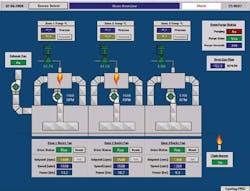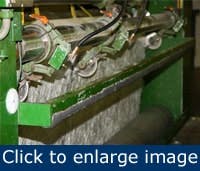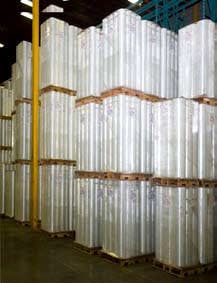Owens Corning fiberglass sheet process
Owens Corning manufactures building materials systems and composite solutions, with a corporate commitment to sustainability. It produces high quality, long-lasting products — while taking measures to conserve natural resources and minimize its process impact. Owens Corning reduces its carbon footprint by incorporating recycled content, conserving natural resources and reducing greenhouse gas emissions. As part of a company-wide effort to reduce energy costs, Owens Corning’s Guelph Glass Plant installed real-time metering equipment to measure and monitor energy use for its major manufacturing processes. Energy-intensive blowers, fans, pumps and compressors are required to move, heat and cool the tons of molten glass used to produce glass fibers. The 400,000 sq.-ft. facility in Guelph, Ontario, produces tens of thousands of tons of glass fiber annually to make products such as interior car-door panels, ladder rails, bath tubs and windmill blades. The process begins by melting raw sand into molten glass at a temperature greater than 2,500°F. The molten glass is extruded into thin strands like fishing line, which are cooled quickly by a fine water mist and cooling air. Sizing is applied to the cooled strands, which are then wound onto spools or ‘cakes,’ and are dried and cured in ovens.
The dried cakes are fed into the chop strand mat line where they’re chopped into 2-in. to 3-in. long strands. These glass fibers are distributed onto a moving conveyor, where a thermoset resin binder and water are added. The product then goes through a three-zone oven that cures the binder to form an integral web, and the sheet of mat material is wound into rolls. Since 2007, the Guelph plant has invested nearly $344,000 in energy conservation projects as part of a multi-million dollar investment in energy efficiency at Owens Corning operations around the world. The investment in 10 energy-efficiency projects at the Guelph plant reduces electricity consumption by more than 2.3 gigawatt-hours annually and saves more than US$150,000 a year.
Challenge
One of the challenges for the Guelph site was to find ways to reduce the energy costs of the fans on the critical cooling section of the chop strand mat line. Owens Corning aimed to reduce the speed of the 125-hp cooling fan, and of the three 40-hp recirculation fans on the oven, while not affecting product integrity.
Fiberglass rolls
Improper cooling can reduce the tensile strength of the web and cause it to break as it’s being wound into rolls. Using real-time metering equipment, the plant engineers evaluated the potential savings of installing variable speed drives (VFDs) on the fans, and verified that reduced fan speed wouldn’t affect product volume and quality.
“Real-time metering lets you know where you use energy,” says Frank Peel, Owen Corning’s Electrical Engineering Specialist. “And if you make changes you can see where the paybacks are. You don’t know what you’re losing unless you measure it.”
Measurement also was essential to determine the potential return on investment required to apply for the Ontario Power Authority’s Electricity Retrofit Incentive Program (ERIP). The ERIP promotes hydro conservation and management by focusing on improvements in lighting, motors, heating, ventilation, air conditioning (HVAC) and overall electrical systems. Owens Corning’s corporate energy leader approves energy reduction projects based on the best dollar per-kilowatt savings and a maximum three-year simple payback. Getting an ERIP rebate can make the difference in getting a project approved. By using VFDs, this project aimed to reduce the fan speeds to 80% to achieve a 50% energy savings, with return on investment in less than one year.
Another challenge was to install drives compatible with the Guelph plant’s existing control system and communication networks.
“Many drive brands support networks like DeviceNet,” says Peel. “But they typically lack the flexibility to easily map specific data like motor kilowatts, bus voltage and fault code. It usually requires explicit messaging in the PLC code, which tends to be complicated.”
Solution
Owens Corning’s Guelph plant engineers turned to its partner of more than 30 years, automation solution provider Rockwell Automation and its local Westburne Ruddy drives specialist. They recommended Allen-Bradley PowerFlex 7-Class AC drives for motor controls that integrate with the existing Allen-Bradley PLC-5 programmable automation controllers and remote I/O and Flex I/O at the plant. Owens Corning found that using Allen-Bradley drives to support the remote I/O is simpler and more cost-effective than adding a new network to communicate to another brand of drive.
{pb}Oven overview screen
A PowerFlex 700 AC drive controlled the 125-hp cooling fan, and three PowerFlex 70 AC drives were installed on the 40-hp oven recirculation fans. PowerFlex drives have a broad spectrum of attributes that met Owens Corning’s needs for space, flexibility and reliability, including monitoring, safety, configuration, installation and space-saving features. The advanced motor control performance helps gather process information at the drive level and automatically disperse it to any part of the plant via remote I/O.
The RSLogix software also helps reduce programming time and helps provide easy startup, diagnostics and troubleshooting. Owens Corning operators and maintenance staff use the drive features to monitor the motor kilowatts, drive status, speed, fault code and output torque.
“I can easily map data out of the PowerFlex drive,” says Peel, “where I’ve found other drives are more cumbersome.”
Diagnostic information also can contribute to plant safety. If a broken belt stops an oven fan, the loss of air circulation could start a fire. Using the drive’s torque feedback, the PLC monitors the motor load on the fans, detects a belt break as soon as it happens and alerts the operators. The flame safety system pressure switches detect the loss of air flow and shut down the burners.
Challenge
- Reduce energy use on fan applications
- Compatibility with existing control system and communication networks
Solutions
Intelligent Motor Control:
- Allen-Bradley PowerFlex 700 AC Drive
- Allen-Bradley PowerFlex 70 AC Drive
- DriveExecutive software
Results
- Energy savings of nearly 57%
- Annual energy savings of 538 MW-hours
- Payback of $50,000 in energy savings annually
- Packback less than one year
- Reduced fan speed also contributes to longer motor life, increased safety and reduced use of natural gas on the oven burners
“This didn’t replace any of the conventional or regulatory combustion interlocks, but it provides an extra measure of safety above the traditional pressure switch to confirm flow on a flame safety system,” states Peel.
PowerFlex drives, 68% smaller than other global drives, also save panel space. For Owens Corning, the PowerFlex 70 drives had the advantage of a smaller footprint than competitors’ drives, which was critical because of panel space constraints.
Peel used DriveExecutive software to program the drives and RSLogix 5 to make the changes in the PLC to control and monitor the new drives.
The PowerFlex startup wizards assisted Peel when setting commonly used drive variables to simplify the startup process. Instead of viewing a linear list or groups of variables, the startup wizards use graphics and text to step through the configuration process.
Results
The installation of the PowerFlex VFDs helps Owens Corning achieve its sustainability goals by providing energy savings of nearly 57% on the chop strand mat line fans, with a return on investment in less than one year. Reduced fan speed also contributes to longer motor life, increased safety and reduced use of natural gas on the oven burners.
The four PowerFlex drives help provide Owens Corning with total annual energy savings of 538 megawatt-hours. Payback on the investment in drives was approximately 10 months.
[pullquote]“The results were dramatic on the 125-hp fan,” says Peel. “We were able to reduce the energy it was using from 88 kw to less than 40 kw. The payback on that drive was less than six months, and there was no negative effect on the product’s tensile strength.”
Since installation of the three PowerFlex 70 drives on the oven zones, the 40-hp fans reduced speed from 1,800 rpm at full speed to 1,500 rpm on two of the fans, and 1,350 rpm on the third, reducing kilowatt usage from 56 kW to 21 kW.
An unexpected advantage of reducing the fan speed with drives is a 7.5 cubic meter per hour reduction in the amount of natural gas used in the ovens.
With less air circulating, there’s less heat loss, resulting in less gas to maintain the temperature, for $1,000 to $1,400 gas savings per month and annual electricity savings of $15,000. The drives also contribute to safety at the ovens, through diagnostic capabilities such as drive torque feedback.
In addition, the drives helped produce cost savings through reduced engineering time, minimized wiring, faster start-up, easier access to data, superior diagnostics and easier maintenance. The drives also promote sustainability by helping to protect the fan motors for longer equipment lifespan.
Owens Corning’s results provided a total payback of $50,000 in energy savings annually, and they received a $4,693 payback from the Electricity Retrofit Incentive Program. The project is a huge success that helps Owens Corning’s bottom line, while adhering to the company’s goals of sustainability.
Peel says two more energy-efficiency projects will be in place by year’s end, including a new control system for the plant’s chillers, which will reduce electricity consumption by an additional 150 megawatt-hours per year. Owens Corning plans to add Modbus communication to the chillers and automate their start-up and temperature setpoint with a CompactLogix PLC.
These results are specific to Owens Corning’s use of Rockwell Automation products and services in conjunction with other products. Specific results might vary for other plants.



